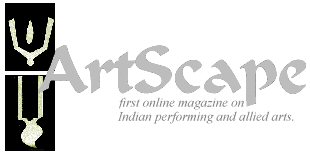ARTICLES
www.artindia.net
does not take any responsibility whatsoever
with regard to articles/ reviews/ previews /information published here.
Any suggestions/ comments /complaints etc. may be sent directly to the
writers/ contributors directly. We invite
you to contribute articles/ reviews etc. to ArtScape. You may sent in
your stories to art.india@yahoo.com along with scanned pictures.
 GS
RAJAN is a music composer, classical flautist and an arts administrartor.
A product of Rukmini Devi Arundale's Kalakshetra, he is a disciple of
MD Ramanathan in vocal music and H Ramachandra Shastri in Flute.
GS
RAJAN is a music composer, classical flautist and an arts administrartor.
A product of Rukmini Devi Arundale's Kalakshetra, he is a disciple of
MD Ramanathan in vocal music and H Ramachandra Shastri in Flute.
A former Deputy Secretary of the National Academy of Music, Dance and Drama (SNA) of the Government of India, Rajan continues to be the festival director of many International festivals.
Indian Music
by GS RAJAN
Whenever there is talk of the spirituality of Indian music and dance, there is always one bunch of cynics who insist that there is no spirituality left in the arts, and that if any matters of the spirit are left at all, they are in the bottle that is uncorked after the recital. While this is of course an extreme and irreverent view, it was certainly a good idea on the part of Swaralaya to organize a two-day seminar on the spiritual Dimensions of Indian Music at the India Habitat Centre, so that interested people could form an opinion for themselves. Speakers from different parts of India graced the dais. They included eminent mridangist and vocalist from Chennai, TV Gopalkrishnan ; critic Manjari Sinha from Secunderabad; Carnatic vocalist Vasumati Badrinathan from Mumbai; and Dr. SK Saksena, noted musicologist of Delhi. Deepti Bhalla Omcherry, Mohini Attam dancer and vocalist, and sitar exponent Dr Suneera Kasliwal were also among the speakers from Delhi.
While the mornings were taken up by lectures, the evenings were devoted to short music recitals by Madhup Mudgal (Hindustani vocal), Bhagyalakshmi Chandrasekhar (veena), GS Rajan (Carnatic flute) and Mita Pandit (Hindustani vocal). Many of the speakers dwealt on the wealth of spiritual material available in the text of the music compositions, such as the kritis of the Carnatic music trinity of Tyagaraja, Muthuswami Dikshitar and Shyama Shastri, as well as the works of the Alwar saints. The Vaishnava influence on Carnatic music was quite thoroughly covered. Vasumati Badrinathan's lecture focussed on the contribution of the Alwar saints whose Tamil poetry contains high philosophy and has been popularised in the form of verses known as the Divya Prabandham. It is music that has kept these works of philosophy alive through the ages, and they were meant originally to be sung and not simply recited, she pointed out. She enlivened the lecture by melodiously rendering some compositions of the Alwar saints.
TV Gopalkrishnan, whose topic was Nada Yoga, focussed on Tyagaraja's compositions extolling this science, and also regaled the listeners by singing some of the great composer's kritis on this subject. Suneera Kasliwal spoke on the relationship of Indian music and especially the veena to Saraswati, the Hindu goddess of learning, and pointed out that music is a universal language of the soul and a vehicle to attain liberation. She illustrated her talk with recordings of two great but rare artists of theh twentieth century, Nikhil Banerjee and Ali Akbar Khan, whose music crosses all barriers of personality, language, creed, etc., and unites the listener with the artist in a common quest. Deepti Balla Omcherry's lecture demonstration emphasized the aspect of Devi worship in music, and highlighted the compositions of great Devi upasakas such as Shyama Sastri, Mutuswami Dikshitar and others, who attained great spiritual heights thanks to their devotion to the Divine Mother through the medium of their music. While all these speakers and musicians stressed on the devotional, theological aspect of spirituality, Manjari Sinha made a very important point when she stated that spirituality is not to be equated with religion at all. Speaking in Hindi, she pointed out that spiritual, or adhyaatmic, is not the same as religious, or dhaarmic.
© Art India Net. ® 1998--2007. We welcome your suggestions and comments to improve this site. Please post an e-mail to add information.
Founder/ Content Editor/ Site Construction/ Maintenance: GS Rajan, Technical Advisor: Sudhir Gandotra Hosted by Communicators - Indserve Infotech P Ltd. © ®
